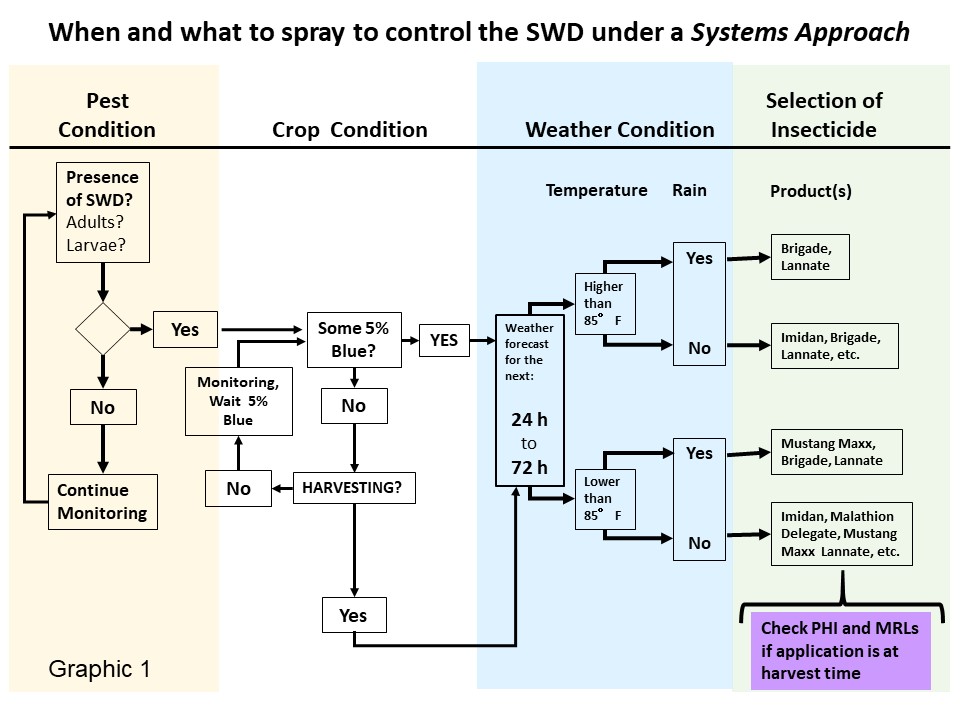West central Michigan small fruit update – July 16, 2019
When reviewing your spotted wing Drosophila management program, consider the weather conditions at the target site when selecting the best insecticides.
West central Michigan is entering a summer drought period that is becoming more frequent in the fruit growing region. So far, no more than a half-inch of rain accumulated in the area during the last 15 days. In addition, daily maximum temperatures averaged 90 degrees Fahrenheit and the minimum temperatures averaged 65 F. This combination of lack of precipitation and high temperatures increased the demand for supplemental irrigation for all small fruits, but especially for blueberries and raspberries.
Red raspberry harvest is underway in the area. Quality is very good and yields are excellent. There are no problems so far. However, spotted wing Drosophila (SWD) started showing up in fields that had strawberries as the first crop. Some fruit infestation has been detected at those places, but it is not a serious problem yet.
Blueberries are in harvest. In southwest Michigan, harvest is underway for Bluetta, Waymouth and Duke. Growers this week are conducting the second harvest for Duke. Bluecrop also started this week with small volumes. So far, quality and yields are good.
There are some problems related to the summer drought and high temperatures, which are affecting fruit firmness in ripe fruit. In addition, they may affect fruit size in varieties still in the green fruit stage or coloring. To prevent these problems, apply supplemental irrigation where water is available.
SWD numbers are starting to increase at blueberry fields in all locations. Traps are registering between two to 12 females per trap, and some fruit infested with SWD larvae has been reported in strawberries and raspberries, but not yet in blueberries. Thus, it is time to review your SWD management program for successfully managing this pest. To do so, we recommend the following.
Have an early warning system/monitoring; install one trap per five to 10 acres just before fruit turns blue. Use a new commercial lure (Trece, Scentry, etc.) and soapy water, or yeast-sugar bait with yellow sticky card for easier adult identification. Sample fruit using salt solution in-field, before and after insecticide applications, and especially before taking it to processors.
Choose effective insecticides for SWD (consider coverage and rotation). Persistence and effectiveness of insecticides are immediately affected by temperature and relative humidity in the target area. High temperatures and low relative humidity will cause a large amount of insecticide to evaporate. The effectiveness (performance) of insecticides also depend on its behavior, like its capacity to penetrate and move inside (translocation) the plant tissue or fruit. Penetration and translocation protect the insecticide from inactivation by temperature or rain.
Timing insecticide applications
Based on your monitoring program for flies and fruit infestation:
- Determine if an insecticide application is required. You may require targeting SWD flies and larvae at the same time.
- Check Michigan State University’s Enviroweather for current and forecasted weather conditions (check the extended weather forecast for the next 24, 48 and 72 hours) before programming or reapplying an insecticide application.
- Look at Graphic 1 (see below) to know which insecticide to spray.
- Select and match the properties (resistance to degradation by temperature and rain and penetration into fruit) of the insecticide with current and forecasted weather conditions.
- Organophosphate and carbamate insecticides such as Imidan and Lannate, are more toxic at temperatures ranging from 62 to 99 F.
- Pyrethroid insecticides toxicity is adversely affected by temperatures higher than 86 F. Brigade is the exception; the higher the temperature, the more toxic the compound.
- When selecting an insecticide, consider its penetration to meet Maximum Residues Limits allowed.
- Understand the labels (PHIs, REIs, season limits).
Main recommended insecticides are:
- Broad spectrum: Lannate, Malathion, Imidan, Mustang Max, Danitol, Brigade, Hero (Brigade+Mustang Max)
- Reduced-risk: Delegate/Radiant
- Organic: Entrust, Pyganic

NOTE: Recommended insecticides listed in Graphic 1 are the only insecticides for which their behavior on blueberries has been amply studied and information regarding fruit penetration, translocation and rainfast characteristics are available. You may find other recommended insecticides in the Michigan Fruit Management Guide (MSU Extension Bulletin E154).



 Print
Print Email
Email
